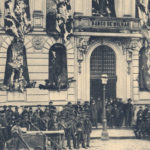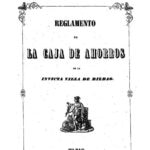A brief history of BBVA (II): The peseta: a new currency to replace the real
After a successful beginning as commercial and issuing bank, Banco de Bilbao faced the 1860s seeking to solidify its position as the leading financial institution in the city. It was a decade of turmoil in Spain, riddled by social and economic events that would put the bank’s strength and credibility to the test.

From the very inception of Banco de Bilbao, its leaders harbored the intention of creating a savings banks that would be controlled by the bank itself. The project turned came to fruition in March 1861, after overcoming a series of hurdles, most of them resulting from the opposition of Caja de Ahorros y Monte de Piedad de Madrid. After earning approval from pertinent authorities, Banco de Bilbao's savings bank would become the first savings bank controlled by a bank in Spain. The intention was no other than to enable the working classes of the city to enjoy a certain level of economic prosperity by earning interests on their deposits. Although the Bank’s recently created institution was the first one of its kind, it was by no means the first savings bank in the capital. Caja de Ahorros de la Invicta Villa de Bilbao was founded in 1845 by Bilbao’s financial elite and affluent families.
Banco de Bilbao’s savings banks main purpose was to channel the impositions of the city’s wage earners, which, according to the book records of the institution, included, in this order: servants, craftsmen, sailors and seamstresses. Upon completing all the necessary formalities for rolling out the new savings bank, the Civil Government of Vizcaya forwarded a notification to the Royal Commissioner responsible for the supervision of the bank, warning him about “the importance and services that should be provided to the people of this capital city by the opening of such a philanthropic institution, one that will certainly yield proper results in the moral and economic order of the families.”

First page of the regulations of the Caja de Ahorros de la Invicta Villa de Bilbao
At this stage in the 19th century, not too many transactions were carried out using notes issued by Banks, which were almost exclusively used in more important commercial operations. People on the street used metal cash, while, in international operations, gold predominated as commercial exchange factor. One of the tasks that issuing banks such as Bilbao were responsible for was preventing shortages of cash for most common operations among private individuals in their areas of influence. The bills of exchange and other securities that were drawn were sent to the Spanish capital where they were accepted in exchange of gold and silver coins that were then picked up by officers of the provincial bank, to replenish their respective city's cash stocks.
During the first two years of the 1860s, Banco de Bilbao ceased being the only financial institution in the city. Encouraged by its success, and taking into advantage the recently passed banking law, three new companies were established: Sociedad General Bilbaína de Crédito, Crédito Vasco and Caja de Descuentos de Bilbao. Among the three new institutions, and for long as there managed to stay alive, it was Crédito Vasco that proved the fiercest competitor for the already veteran Banco de Bilbao. However, the banking panic crises that took place in 1864, 1865, and 1868 triggered the demise of these new banking institutions. Banco de Bilbao, however and despite all the troubles it had to endure, was able to pull through, emerging as an even more robust bank.

The old bridge and the church of San Antón of Bilbao, 1874. - Diputación Foral de Vizcaya
These crises did not hit Bilbao as hard as they did other cities. Bank policies (increase of interest rates on loans and the discounts to decrease the amount of notes in circulation), combined with the cautious approach with which the local merchants embraced credit, helped to mellow difficulties down a bit. However, Banco de Bilbao was really hurt by the bankruptcy of the Tudela-Bilbao Railway Company, in what turned to be institution's first truly threatening experiences from a financial standpoint.
The bank, which was the second largest creditors of the Railway Company, was linked to over 26% of the company’s debt and therefore gave its approval to the agreement with the company’s creditors. The terms of the agreement envisaged the issue of a 5% yield mortgage bond with a maturity term of 72 years. As the bank’s articles of incorporation did not admit the pledging of the aforementioned securities as collateral, its board of directors requested the minister of finance’s approval in order to have them amended. Once authorized, Banco de Bilbao validated the obligations as collateral of the loans, for up to 80% of their current price. The arrangement was instrumental for soothing merchants and entrepreneurs, and from then on the bank abandoned its restrictive policy, to adopt a more expensive one.
That same year, Banco de Bilbao moved to a new headquarters: The St. Nicholas Palace, on number 4 of the small plaza that lent its name to the building. Today, the Palace is still home to one of BBVA’s corporate offices.

Balcony of the St. Nicholas' Palace. - BBVA Historical Archive
Those were times of change for the Spanish society and the banking industry. On October 19, 1868 a new tender was introduced in Spain to replace the real; the peseta. Also on March 19, 1874 a very significant event took place. José Echegaray, minister of finance - who would the distinguished with the Nobel Prize in literature some years down the line- merged all local issuing banks with the Bank of Spain. This initiative turned the National institution into the only one capable of issuing legal tender in Spain. However, the new regulation allowed all banks that had been performing this double commercial and issuing function until then to continue performing the first of the functions. The banks of Bilbao, Santander, Barcelona, Reus and Tarragona were the only ones that adapted to the new situation.. To compensate the affected institutions for their loss of issuing faculties, the so-called Echegaray Decree established the granting of a 150 million peseta bank loan. The change was motivated by the complex economic and financial situation of a Spain immersed in the Cuban War (the first one) and in the Third Carlist war.
Another one of the most prominent resolutions of the era by the Government of Spain was the concession, approved by law, of the creation of the Banco Hipotecario de España S.A. to the Banque de Paris et the Pays-Bas, S.A. It was agreed in exchange for a 100 million peseta loan at a 12% interest rate, that would be granted by the promoter to the Spanish government, and would be exclusively intended for the payment of the pending interests of the Public Debt. Besides Banque de Paris et des Pays-Bas, S.A., the other founders were Le Credit Foncier, Banco de Castilla, S.A., Societè Generale pour favoresir le developpement de l´industrie et du comerce en France, and the Urquijo Family. Finally, the old idea of the Marquis of Salamanca – to create a mortgage bank that would provide oxygen for the State during complex times, such as the ones that Spain was going through when its creation was approved as a result of the wars.
Sources consulted:
- ‘La Banca como motor de desarrollo en España: 150 años de historia bancaria, 1850-2000’. Autor: José Víctor Arroyo Martín
- ‘Un siglo en la vida del Banco de Bilbao. Primer centenario (1857-1957)’. Varios autores
- ‘Cientocincuenta años, cientocincuenta bancos’. Autores: Manuel Jesús González, Rafael Anes e Isabel Mendoza
- ‘La banca de Bilbao en el proceso de industrialización. 1850-1914’. Autor: José Víctor Arroyo Martín
- ‘Las Cajas de Ahorros en los mercados financieros del País Vasco, Navarra y La Rioja: características y su comportamiento expansivo entre 1940 y 1960’. Autor: José Víctor Arroyo Martín